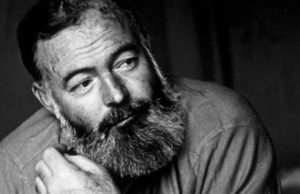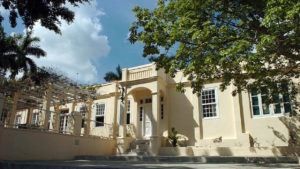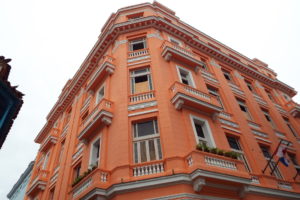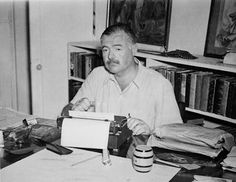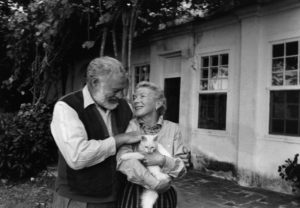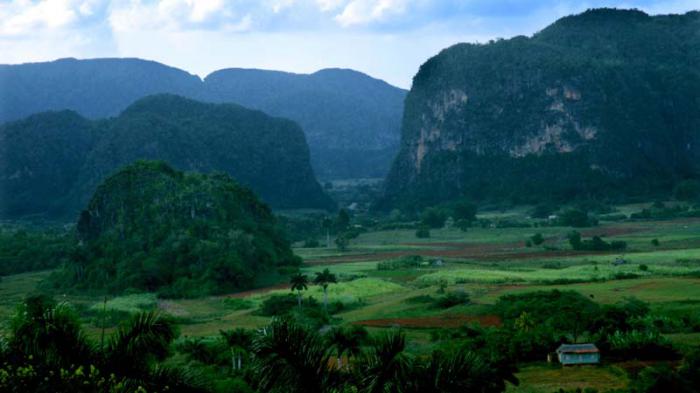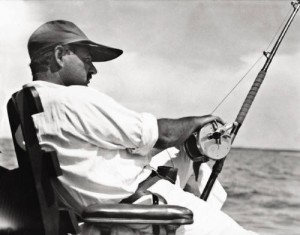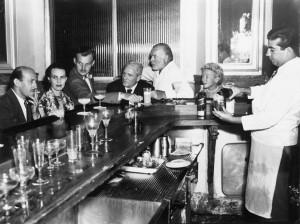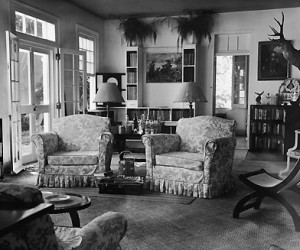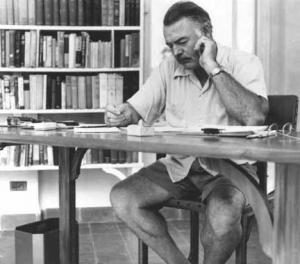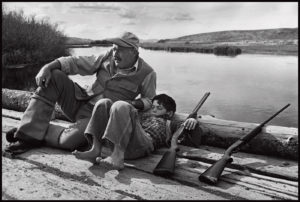Ernest Hemingway arrived in Cuba in the first half of April 1928. He and Pauline Pfeiffer, his second wife, made the transit here for Key West, where he would finish ‘Farewell to Arms’. He returned in 1932 to fish needles in Cuban waters. He returned in 1933 and wrote the first of his Cuban chronicles. From then on, he would never disassociate himself from this “long, beautiful and unhappy island,” as he called Cuba in The Green Hills of Africa. ‘The old man and the sea’ (1952) is, by excellence, the “Cuban” novel by Hemingway. Part of the plot of Islands in the Gulf (1970) takes place in Cuba. Also in some other story and in many of his newspaper articles there are allusions to the Island. The scenario of Having and Not Having (1937) is largely Cuban.
On one occasion he expressed with regard to Cuba: “I love this country and I feel at home; and where a man feels at home, apart from the place where he was born, that is the place to which he was destined. ”
Ernest Hemingway lived in this house for the last 22 years of his life. When he settled in Finca La Vigia – about 30 minutes from downtown Havana – he was about to conclude ‘For Whom the Bell Tolls’. By abandoning it forever, he had already traveled as a writer on the road to fame and deserved the Nobel Prize. On the estate were his Royal laptop, the tombs of his dogs, about 50 cats and the nine thousand volumes he treasured throughout his life and many years later would exclaim to García Márquez: “What a rarer library had this man!”
Hemingway was, in the decade of the 30, a suspiciously recurrent tourist that every year spent in Cuba during the months of May, June and July, which are the run of the needle.
For his chronicle “The fishing of the needle at the height of the Morro”, with which he returned to journalism after having stayed away from that profession for more than ten years, not many of the customs of that guest of the Ambos Mundos are known.
Sometimes in shorts, with Basque shoes, almost always without socks and with a light shirt, you could see him walking down Calle Obispo. In Islands in the Gulf he would evoke the smells characteristic of that way: that of flour stored in sacks and that of flour dust, that of freshly opened packaging boxes, the smell of roasted coffee, “which was a stronger sensation that of a drink in the morning, “the delicious smell of tobacco …
The writer felt at ease in the Ambos Mundos, because of the centrality of the area and the proximity to the port, where he anchored his yacht. But Martha Gelhorn, her third wife, began to annoy her anonymous and depersonalized room and lack of privacy before the visit of her husband’s friends. It was she who sought and found Finca Vigia. Hemingway, at first, disliked the place: it was too far from Floridita.
A good part of the history of his book ‘Islands in the gulf’ takes place in this habanero bar. In these pages of the novel, the reader sees a character wanderer whom the writer calls Liliana the honest. In real life was called Leopoldina, a mulatto prostitute who “did the life” in the Floridita and that was the great Cuban love of the novelist. He would remember her in Islands in the Gulf: “She had a beautiful smile, wonderful dark eyes and splendid black hair … She had a smooth complexion, like an ivory olive, if such an ivory existed, with a slight pink hue …”
In 1949, he explained in a chronicle the reasons for his long Cuban residence. He spoke, of course, of the Gulf Stream, “where there is the best and most abundant fishing I have ever seen”; of the 18 kinds of mango that were harvested on his property, his breeding of fighting cocks … and pointed as if by carelessness: “You live on this Island … because in the morning cool you work better and more comfortably than anywhere else. ”
There he concluded ‘For Whom the Bell Tolls’ and wrote ‘Through the River and Among the Trees’, ‘The Old Man and the Sea’, ‘Paris was a Feast’ and ‘Islands in the Gulf’. Also another novel that left unfinished, ‘The Garden of Eden’. And also many articles and chronicles for periodicals, among them the report A bloody summer, about the hand-to-hand between bullfighters Antonio Ordonez and Luis Miguel Dominguín, who witnessed in Spain the previous year, and who, say his biographers, had many difficulties to conclude.
“I always had good luck writing in Cuba … expressed in a letter. And shortly after learning that he had won the Nobel Prize, he declared in an interview: “This is a prize that belongs to Cuba, because my work was conceived and created in Cuba, with my people from Cojimar, where I am a citizen. Through all the translations is present this adopted country where I have my books and my house “.
In a journalistic chronicle of 1936, Hemingway counted in less than 200 words the story that he would display years later in The Old Man and the Sea. The scholars agree that it was inspired by a fisherman of Cojímar called Anselmo Hernandez, which does not exclude that other fishermen of the zone contributed elements to its personage. The anecdote of the novel is known. Its meaning is very evident. Hemingway puts it in the mouth of Santiago, the protagonist: “Man is not made for defeat. A man can be destroyed but not defeated”. The stage of the novel is the sea, and the old man’s fight against the sharks that end up snatching his fishing, is the man’s life. The writer would say: “I tried to make a real old man, a real boy, a real sea, a real fish and real sharks. But if I made them right and true enough, they can mean many things. When you write well and sincerely about one thing, that thing will mean many other things afterwards. ” And he will say without ambition or modesty that with the old man and the sea “it is as if he had finally given expression to what I pursued my whole life.”
He wrote, in recent years, on the skin of lesser Kudu, because he “thought more clearly.” He got up early and only gave up his work when he reached a point where he knew exactly what would happen next. To achieve, during a day, about 500 “clean” words was satisfactory to him, and he never directly harmed the most difficult passages, but the dialogues.
Finca Vigía was, says García Márquez, the only truly stable house the writer had in his life. Mary Welsh, her fourth and last wife, put, as far as she could, order in the estate and in the existence of the novelist. As he complained about how much the visitors annoyed him, Mary arranged the construction of the three-story tower next to the house. The last floor would be Hemingway’s workroom. He went up one day and remained there for fifteen minutes, during which he vainly endeavored to write a sentence. He went down and never used the site again to write. He said he could not resist the loneliness.
HE KILLED HIMSELF HOW HE LIVED.
“Look how I’m going to kill myself,” he told his friends at Finca Vigia. He placed the butt of his shotgun on the floor and rested the barrel on the roof of his mouth. Then he pulled the trigger with the thumb of a foot. There was a dry click. He exclaimed smiling, “This is harakiri’s technique with a rifle.”
Finca Vigia, besides a current museum of many of its old properties, remains Hemingway’s house. Empty seems, however, full of life. It gives the impression that its owner is not dead, but absent and that from one moment to another it will return of the Floridita or of a hunt.
ERNEST HEMINGWAY Y SU HAVANA.
Hemingway llegó a Cuba en la primera quincena de abril de 1928. Junto a Pauline Pfeiffer, su segunda esposa, hizo aquí el tránsito para Cayo Hueso, donde concluiría Adiós a las armas. Volvió en 1932 para pescar agujas en las aguas cubanas. Regresó en 1933 y escribió la primera de sus crónicas de tema cubano. A partir de entonces no se desvincularía jamás de esta “isla larga, hermosa y desdichada”, como llamó a Cuba en Las verdes colinas de África. El viejo y el mar (1952) es, por excelencia, la novela “cubana” de Hemingway. Parte de la trama de Islas en el golfo (1970) transcurre en Cuba. También en alguno que otro cuento y en muchísimos de sus artículos periodísticos hay alusiones a la Isla. El escenario de Tener y no tener (1937) es cubano en buena medida.
En una ocasión expresó con relación a Cuba: “Amo este país y me siento como en casa; y allí donde un hombre se siente como en casa, aparte del lugar donde nació, ese es el sitio al que estaba destinado”.
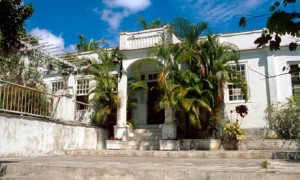 LA VIGIA, HEMINGWAY’S HOUSE IN HAVANA
LA VIGIA, HEMINGWAY’S HOUSE IN HAVANA
Ernest Hemingway vivió en esta casa los últimos 22 años de su vida. Cuando se instaló en la Finca La Vigía –a unos 30 minutos del centro de La Habana- estaba a punto de concluir ‘Por quién doblan las campanas’. Al abandonarla para siempre, había recorrido ya como escritor el camino de la fama y merecido el Premio Nobel. En la finca quedaron entonces su Royal portátil, las tumbas de sus perros, unos 50 gatos y los nueve mil volúmenes que atesoró a lo largo de su vida y que muchos años después harían exclamar a García Márquez: “¡Qué biblioteca más rara tenía este hombre!”
Hemingway era, en la década de los 30, un turista sospechosamente reincidente que todos los años pasaba en Cuba los meses de mayo, junio y julio, que son los de la corrida de la aguja.
Por su crónica “La pesca de la aguja a la altura del Morro”, con la que volvió al periodismo luego de haberse mantenido alejado de esa profesión durante más de diez años, se conocen no pocas de las costumbres de aquel huésped del Ambos Mundos.
A veces en bermudas, con zapatillas vascas, casi siempre sin calcetines y con una camisa ligera, se le veía caminar por la calle Obispo. En Islas en el golfo evocaría los olores característicos de esa vía: el de la harina almacenada en sacos y el del polvo de harina, el de las cajas de embalaje recién abiertas, el del olor del café tostado, “que era una sensación más fuerte que la de un trago por las mañanas”, el delicioso olor a tabaco…
El escritor se sentía a gusto en el Ambos Mundos, por lo céntrico de la zona y la cercanía con el puerto, donde fondeaba su yate. Pero a Martha Gelhorn, su tercera esposa, comenzaron a incomodarle la habitación anónima y despersonalizada y la falta de privacidad ante la visita de los amigos del marido. Fue ella la que buscó y encontró Finca Vigía. A Hemingway, al inicio, le desagradó el lugar: quedaba demasiado lejos del Floridita.
Una buena parte de la historia de su libro ‘Islas en el golfo’ transcurre en este bar habanero. En esas páginas de la novela, el lector ve deambular a un personaje a quien el escritor llama Liliana la honesta. En la vida real se llamó Leopoldina, una prostituta mulata que “hacía la vida” en el Floridita y que fue el gran amor cubano del novelista. La recordaría en Islas en el golfo: “Tenía una hermosa sonrisa, unos ojos oscuros maravillosos y espléndido pelo negro… Tenía un cutis terso, como un marfil color olivo, si tal marfil existiera, con un ligero matiz rosado…”
En 1949, explicó en una crónica las razones de su larga residencia cubana. Habló, por supuesto, de la Corriente del Golfo, “donde hay la mejor y más abundante pesca que he visto en mi vida”; de las 18 clases de mango que se cosechaban en su propiedad, de su cría de gallos de pelea…y apuntó como al descuido: “Uno vive en esta Isla (…) porque en el fresco de la mañana se trabaja mejor y con mayor comodidad que en cualquier otro sitio.”
Allí concluyó ‘Por quien doblan las campanas’ y escribió ‘A través del río y entre los árboles’, ‘El viejo y el mar’,’París era una fiesta’ e ‘Islas en el golfo’. También otra novela que dejó inconclusa, ‘El jardín del Edén’. Y asimismo muchísimos artículos y crónicas para publicaciones periódicas, entre ellos el reportaje Un verano sangriento, acerca del mano a mano entre los toreros Antonio Ordóñez y Luis Miguel Dominguín, que presenció en España el año precedente, y que, dicen sus biógrafos, tuvo muchas dificultades para poder concluir.
“Yo siempre tuve buena suerte escribiendo en Cuba… expresó en una carta. Y poco después de conocer que había ganado el Premio Nobel, declaró en una entrevista: “Este es un Premio que pertenece a Cuba, porque mi obra fue pensada y creada en Cuba, con mi gente de Cojímar, de donde soy ciudadano. A través de todas las traducciones está presente esta patria adoptiva donde tengo mis libros y mi casa”.
En una crónica periodística de 1936, Hemingway contó en menos de 200 palabras la historia que desplegaría años después en El viejo y el mar. Los estudiosos coinciden que se inspiró en un pescador de Cojímar llamado Anselmo Hernández, lo que no excluye que otros pescadores de la zona aportaran elementos a su personaje. La anécdota de la novela es conocida. Su sentido es bien evidente. Hemingway lo pone en boca de Santiago, el protagonista: “El hombre no está hecho para la derrota. Un hombre puede ser destruido, pero no derrotado”. El escenario de la novela es el mar, y la lucha del viejo contra los tiburones que terminan arrebatándole su pesca, es la del hombre por la vida. Diría el escritor: “Traté de hacer un viejo real, un muchacho real, un mar real, un pez real y tiburones reales. Pero si los hice bien y suficientemente verdaderos, pueden significar muchas cosas. Cuando se escribe bien y con sinceridad de una cosa, esa cosa significará después muchas otras cosas”. Y dirá sin ambaje ni modestia que con El viejo y el mar “es como si finalmente hubiera dado expresión a lo que perseguí toda mi vida”.
Escribía de pie, ya en los últimos años, sobre una piel de lesser kudú, porque así “pensaba con más claridad”. Se levantaba temprano y solo abandonaba su labor cuando llegaba a un punto en que sabía con exactitud lo que sucedería después. Lograr, durante una jornada, unas 500 palabras “limpias” era para él satisfactorio, y jamás acometía directamente a máquina los pasajes más difíciles, pero sí los diálogos.
Finca Vigía fue, dice García Márquez, la única casa verdaderamente estable que el escritor tuvo en su vida. Mary Welsh, su cuarta y última esposa, puso, hasta donde pudo, orden en la finca y en la existencia del novelista. Como éste se quejaba de cuánto lo importunaban los visitantes, Mary dispuso la construcción de la torre de tres pisos aledaña a la casa. La última planta sería el cuarto de trabajo de Hemingway. Subió un día y permaneció allí quince minutos, durante los cuales se empeñó, en vano, en redactar una frase. Bajó y nunca más volvió a utilizar el sitio para escribir. Comentó que no podía resistir la soledad.
SE MATÓ COMO VIVIÓ.
“Miren como voy a matarme”, decía a sus amigos en Finca Vigía. Colocaba la culata de su escopeta Mannlicher Schoenauer 265 en el piso y apoyaba el cañón en el cielo de la boca. Luego oprimía el gatillo con el pulgar de un pie. Se oía un chasquido seco. Exclamaba sonriente: “Esta es la técnica del harakiri con fusil.”
La Finca Vigia ademas de un museo actual de muchas de sus antiguas propiedades continúa siendo la casa de Hemingway. Vacía parece, sin embargo, llena de vida. Da la impresión de que su propietario no está muerto, sino ausente y que de un momento a otro regresará del Floridita o de una cacería.
Agencies/CiroBianchi/InternetPhotos/Arnoldo Varona/TheCubanHistory.com
THE CUBAN HISTORY, HOLYWOOD.



